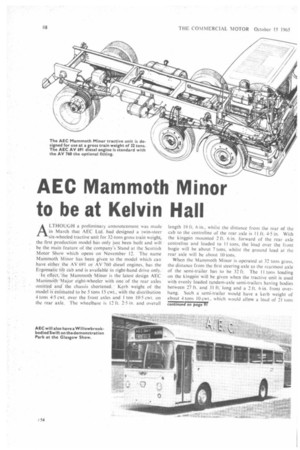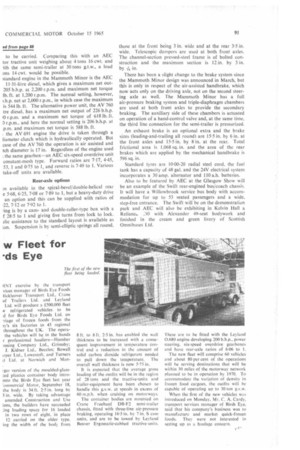AEC Mammoth Minor to be at Kelvin Hall
Page 90

Page 93

If you've noticed an error in this article please click here to report it so we can fix it.
ALTHOUGH a preliminary announcement was made in March that AEC Ltd. had designed a twin-steer six-wheeled tractive unit for 32-tons gross train weight, the first production model has only just been built and will be the main feature of the company's•Stand at the Scottish Motor Show which opens on November 12. The name Mammoth Minor has been given to the model which can have either the AV 691 or AV 760 diesel engines, has the ErgOmatie tilt cab and is available in right-hand drive only.
In effect, the Mammoth .Minor is the latest design AEC MammOth 'Major eight-wheeler with one of the rear axles omitted and the chassis shortened,: Kerb weight of the model k estimated to be 5 tons 15 cwt., with the distribution 4 tons 4.5 cwt. over the front axles and 1 ton 10-5 cwt. on the rear axle. The wheelbase is 12 ft. 2-5 in. and overall length 19 ft. 6 in., whilst the distance from the rear of the cab to the centreline of the rear axle is 11 ft. 4.5 in. With the kingpin mounted 2 ft. 6 in. forward of the rear axle centreline and loaded to 11 tons, the load over the front bogie will be about 7 tons, whilst the ground load at the rear axle will be about 10 tons.
When the Mammoth Minor is operated at 32 tons gross, the distance from the first steering axle to the rearmost axle of the semi-trailer has to be 32 ft, The I I tons loading on the kingpin" will be given when the tractive unit is used with evenly loaded tandem-axle semi-trailers having bodies between 27 ft. and 31 ft: long and a 2 ft. 6 in. front overhang. Such a semi-trailer would have a kerb weight of about 4 tons 10 cwt.. which would allow a load of 21 tons continued on page if
to be carried. Comparing this with an AEC for tractive unit weighing about 4 tons 16 cwt. and ith the same semi-trailer at 30 tons g.t.w., a load ons 14 cwt. would be possible.
standard engine in the Mammoth Minor is the AEC 11-31-litre diesel, which gives a maximum net out205 b.h.p. at 2,200 r.p.m. and maximum net torque lb. ft. at 1,200 r.p.m. The normal setting, however, 1.h.p. net at 2,000 r.p.m., in which case the maximum is 544 lb. ft. The alternative power unit, the AV 760 tre diesel, has a maximum net output of 226 b.h.p.
r.p.m. and a maximum net torque of 618 lb. ft.
r.p.m., and here the normal setting is 206 b.h.p. at p.m. and maximum net torque is 588 lb. ft.
the AV 691 engine the drive is taken through a liameter clutch which is hydraulically operated. But case of the AV 760 the operation is air assisted and teh diameter is 17 in. Regardless of the engine used the same gearbox—an AEC six-speed overdrive unit constant-mesh type. Forward ratios are 7.17, 4-45, 53, 1 and 0-75 to 1, and reverse is 7.49 to I. Various take-off units are available.
Rear-axle options
as available in the spiral-bevel/double-helical rear e 5.68, 6-25, 7-08 or 7-89 to 1, but a heavy-duty drive an option and this can be supplied with ratios of 22, 712 or 7-92 to 1.
-in is by a camand double-roller-type box with a
f 28-5 to 1 and giving five turns from lock to lock. The assistance to the standard layout is available as Lon. Suspension is by semi-elliptic springs all round, those at the front being 3 in. wide and at the rear 3.5 in. wide. Telescopic dampers are used at both front axles. The channel-section pressed-steel frame is of bolted construction and the maximum section is 12 in. by 3 in. by in.
There has been a slight change to the brake system since the Mammoth Minor design was announced in March, but this is only in respect of the air-assisted handbrake, which now acts only on the driving axle, not on the second steering axle as well. The Mammoth Minor has a full air-pressure braking system and triple-diaphragm chambers are used at both front axles to provide the secondary braking. The auxiliary side of these chambers is actuated on operation of a hand-control valve and, at the same time, the third line connection for the semi-trailer is pressurized.
An exhaust brake is an optional extra and the brake sizes (leading-and-trailing all round) are 15-5 in. by 6 in. at the front axles and 15.5 in. by 8 in. at the rear. Total frictional area is 1,068 sq. in. and the area of the rear brakes which are applied by the mechanical handbrake is 596 sq. in.
Standard tyres are 10-00-20 radial steel cord, the fuel tank has a capacity of 48 gal, and the 24V electrical system incorporates a 30 amp. alternator and 110 a.h. batteries_ Also to be featured by AEC at the Glasgow Show will be an example of the Swift rear-engined bus/coach chassis. It will have a Willowbrook service bus body with accommodation for up to 53 seated passengers and a wide, step-free entrance. The Swift will be on the demonstration park and AEC will also be exhibiting in Kelvin Hall a Reliant,. :90 with Alexander 49-seat bodywork and finished in the cream and green livery of Scottish 0 mn i buses Ltd.








































































































































